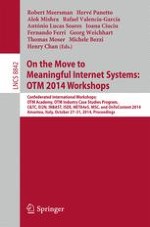This volume constitutes the refereed proceedings of the following 9 international workshops: OTM Academy, OTM Industry Case Studies Program, Cloud and Trusted Computing, C&TC, Enterprise Integration, Interoperability, and Networking, EI2N, Industrial and Business Applications of Semantic Web Technologies, INBAST, Information Systems, om Distributed Environment, ISDE, Methods, Evaluation, Tools and Applications for the Creation and Consumption of Structured Data for the e-Society, META4eS, Mobile and Social Computing for collaborative interactions, MSC, and Ontology Content, OnToContent 2014. These workshops were held as associated events at OTM 2014, the federated conferences "On The Move Towards Meaningful Internet Systems and Ubiquitous Computing", in Amantea, Italy, in October 2014. The 56 full papers presented together with 8 short papers, 6 posters and 5 keynotes were carefully reviewed and selected from a total of 96 submissions. The focus of the workshops were on the following subjects models for interoperable infrastructures, applications, privacy and access control, reliability and performance, cloud and configuration management, interoperability in (System-of-)Systems, distributed information systems applications, architecture and process in distributed information system, distributed information system development and operational environment, ontology is use for eSociety, knowledge management and applications for eSociety, social networks and social services, social and mobile intelligence, and multimodal interaction and collaboration.
